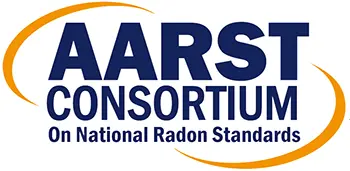AARST: American Association of Radon Scientists and Technologists

AARST, the American Association of Radon Scientists and Technologists, is a nonprofit organization headquartered in Fletcher, North Carolina and founded in 1988. AARST has been creating national radon standards with ANSI approval since the early 2000s. AARST does work in Washington, D.C. on public policy, steadily gaining agreement there that radon is the second leading cause of lung cancer. The leadership of the organization is democratically elected by the members. Standards from AARST are available both individually, directly through the ANSI webstore, and as part of a Standards Subscription. If you or your organization are interested in easy, managed, online access to standards that can be shared, a Standards Subscription may be what you need - please contact us at: [email protected] or 1-212-642-4980 or Request Proposal Price.
Below are AARST's best-selling standards. To find additional standards, please use the search bar above.
ANSI/AARST MAH-2019
Protocol for Conducting Measurements of Radon and Radon Decay Products in Homes
This standard of practice specifies procedures and minimum requirements for measuring radon concentrations in single-family residences for determining if radon mitigation is necessary to protect current and future occupants. This standard applies to homeowners, professionals and any other party seeking to determine if radon mitigation is necessary for real estate or non-real-estate purposes. Limitations - This standard does not address all technical aspects of measurement device technology, quality assurance or techniques to specifically identify radon sources such as radon in water supplies, building materials or relative to the possession and handling of radioactive materials.
ANSI/AARST MAMF-2017 rev.1-21
Protocol for Conducting Measurements of Radon and Radon Decay Products in Multifamily Buildings
This standard of practice specifies procedures and minimum requirements when measuring radon concentrations in shared structures, or portions of shared structures, used for residential, non-residential or mixed use purposes to determine if radon mitigation is necessary to protect current and future occupants. 1-21 revisions to this publication include harmonization of most provisions to read the same across both ANSI/AARST MAMF and ANSI/AARST MALB.
ANSI/AARST SGM-SF-2017 rev.12-20
Soil Gas Mitigation Standards for Existing Homes
This standard specifies practices, minimum requirements and, general guidance for reducing soil gas entry into existing homes in order to mitigate occupant exposures to certain hazardous soil gases, including radon gas, chemical vapors and other hazardous gases. 12/20 revisions harmonize Sections 6, 7 and 8 across ANSI/AARST SGM-SF, RMS-MF and RMS-LB. While recommended for immediate use, the effective date of this revised standard for compliance purposes is Sept. 1st, 2021.
ANSI/AARST MALB-2014 rev.1-21
Protocol for Conducting Measurements of Radon and Radon Decay Products in Schools and Large Buildings
This standard of practice specifies procedures and minimum requirements when measuring radon concentrations in shared structures, or portions of shared structures, used for residential, non-residential or mixed use purposes to determine if radon mitigation is necessary to protect current and future occupants. 1-21 revisions to this publication include harmonization of most provisions to read the same across both ANSI/AARST MAMF and ANSI/AARST MALB.
ANSI/AARST RMS-MF-2018 rev.12-20
Radon Mitigation Standards for Multifamily Buildings
This standard specifies practices, minimum requirements and general guidance for mitigation of radon in existing multifamily buildings, including both low-rise and high-rise multifamily buildings. 12/20 revisions harmonize Sections 6, 7 and 8 across ANSI/AARST SGM-SF, RMS-MF and RMS-LB. While recommended for immediate use, the effective date of this revised standard for compliance purposes is Sept. 1st, 2021.
ANSI/AARST MS-QA-2019
Radon Measurement Systems Quality Assurance
This standard of practice specifies minimum requirements for quality systems designed to quantify the concentration of 222Rn gas in air by qualified professionals and laboratories, whose data are intended to be used to determine the need for, or success of, radon mitigation. This standard is applicable to the wide variety of radon measurement devices used for indoor measurements, primarily in residential environments or buildings not associated with the possession or handling of radioactive materials.
ANSI/AARST MAMF-2017
Protocol for Conducting Measurements of Radon and Radon Decay Products in Multifamily Buildings
This standard of practice specifies procedures, minimum requirements and general guidance for measurement of radon and radon decay product concentrations in Multifamily buildings that have more than one attached dwelling. Provided with this document is an "Informational Introduction to Radon" and an "MAMF Companion Guidance" document that includes informational guidance for residence managers.
ANSI/AARST RMS-MF-2018
Radon Mitigation Standards for Multifamily Buildings
This standard of practice specifies minimum requirements and general guidance for mitigation of radon and soil gas in existing multifamily buildings. The techniques addressed in this standard provide whole-building consideration yet also apply to portions of a building or individual occupied spaces. Improvements to RMS-MF 2018 include harmonized provisions with ANSI/AARST standards RMS-LB (schools and large buildings), SGM-SF (existing homes) and CC-1000 (new construction).
ANSI/AARST RMS-LB-2018 rev.12-20
Radon Mitigation Standards for Schools and Large Buildings
This standard specifies practices, minimum requirements and general guidance for mitigation of radon in existing schools and large buildings, including both low-rise and high-rise schools and large buildings. 12/20 revisions harmonize Sections 6, 7 and 8 across ANSI/AARST SGM-SF, RMS-MF and RMS-LB. While recommended for immediate use, the effective date of this revised standard for compliance purposes is Sept. 1st, 2021.
ANSI/AARST MW-RN-2020
Protocol for the Collection, Transfer and Measurement of Radon in Water
This standard of practice contains minimum requirements and guidance for measuring radon in water that enters a building through groundwater supplies for determining if mitigation is necessary to protect current and future occupants of dwellings and other buildings. This standard includes procedures for the collection and transport of water samples, as well as protocols for the quantitative transfer of the sample to a measurement device to determine radon concentrations in water.





